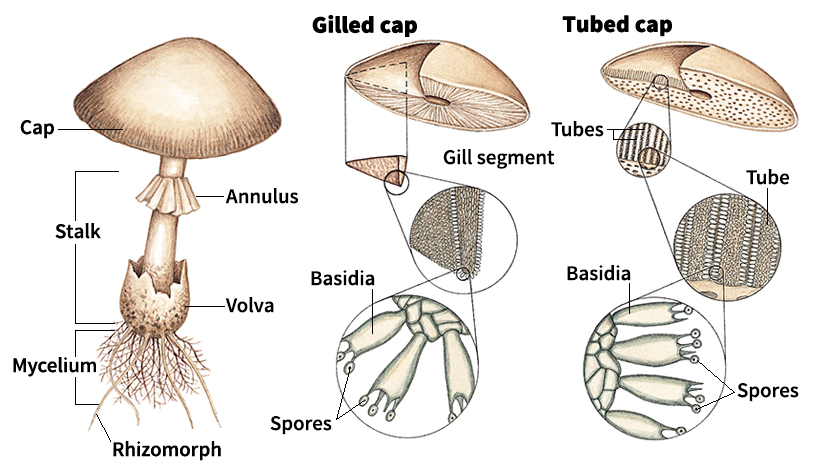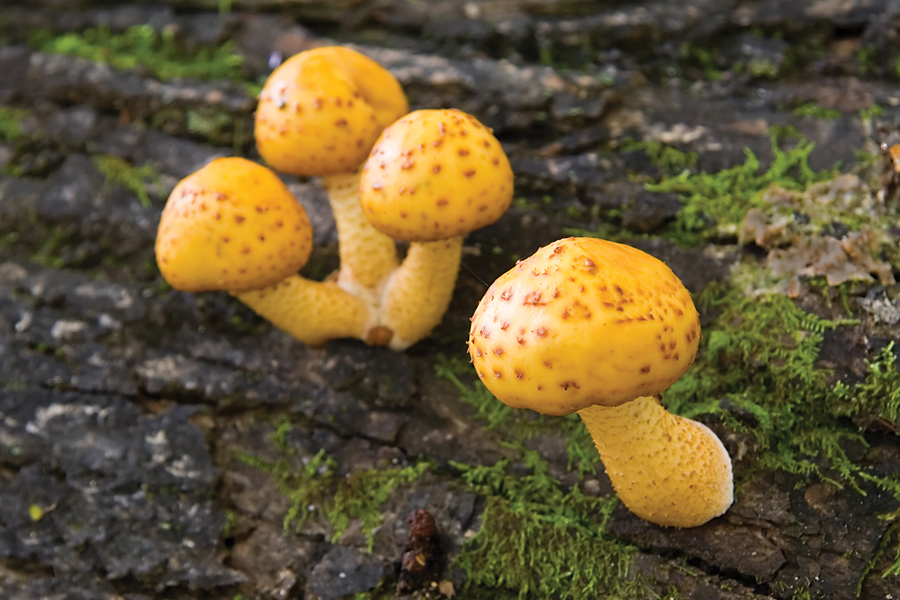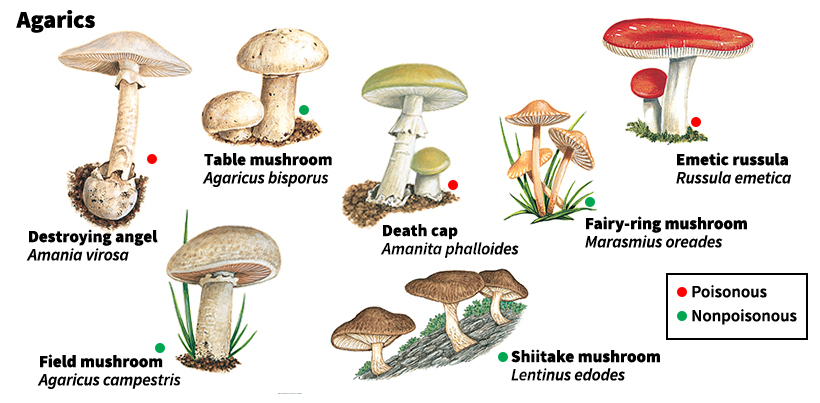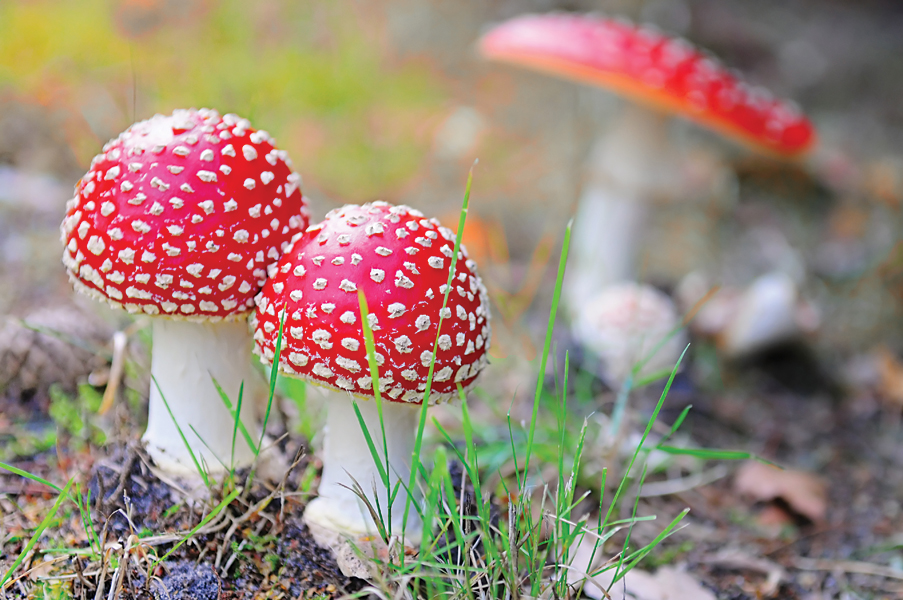Mushroom is any of a variety of fleshy, umbrella-shaped fungi. Mushrooms most commonly grow in woods and grassy areas. There are more than 5,000 species (kinds) of mushrooms worldwide.
Most biologists classify mushrooms and other fungi in a separate kingdom of living things. In the past, scientists considered fungi to be nongreen plants. Like other fungi, mushrooms differ from green plants in that they lack chlorophyll, the green substance such plants use to make food. Instead, mushrooms survive mainly by absorbing food material from living or decaying plants, animals, or other fungi.
A mushroom consists of two main parts: (1) the mycelium and (2) the fruiting body. The mycelium typically grows in soil or wood and absorbs food materials. This part may live and grow many years. The umbrella-shaped fruiting body grows from the mycelium and commonly lives from one to several days. During that time, it produces tiny reproductive cells called spores from which new mushrooms grow. The fruiting body is the part most people consider the mushroom.
Mushrooms vary greatly in size and color. They measure from about 3/4 inch (1.9 centimeters) to about 15 inches (38 centimeters) in height. The diameter of the top of a mushroom ranges from less than 1/4 inch (0.6 centimeter) to about 18 inches (46 centimeters). Most mushrooms have a white, yellow, orange, red, or brown color. Some are blue, violet, green, or black.
Many species of mushrooms are tasty and safe to eat. But others have a bad taste, and some are poisonous. Certain poisonous species can prove fatal if eaten. Mushrooms that are either poisonous or have a bad taste are often referred to as toadstools.
Parts of a mushroom
The mycelium of a mushroom typically consists of numerous white or yellow, threadlike filaments called hyphae. The hyphae absorb food and water for the growth and development of the mycelium, and they eventually produce the mushroom’s fruiting body. In most mushrooms, the filaments form a loose weblike mycelium. However, in some species they bundle together in long rhizomorphs (strands) that resemble shoelaces.

The fruiting body of the mushroom is made up of tightly woven filaments. It consists of a stalk topped by a rounded cap. Most species of mushrooms have thin, vertical, knifelike growths called gills on the underside of the cap. The gills spread outward from the center of the cap like the spokes of a wheel. Species without gills have densely packed, parallel tubes, or occasionally spines, under the cap. Tiny, club-shaped cells called basidia cover the outer surface of the gills or spines or the inner surface of the tubes. The basidia of most mushrooms produce four microscopic spores. The spores are reproductive cells from which new mycelia grow.
In some mushrooms, a clothlike membrane called a partial veil protects the gills or tubes as the mushroom develops. As the cap grows wider, the veil tears. It often remains draped around the stalk, forming a ring called an annulus, or it sometimes decorates the edge of the cap. In other species, a universal veil covers the entire immature mushroom. When the veil breaks, it leaves a volva (cup) or other remains at the base of the stalk. It also may leave warts or patches on the top of the cap.
The life of a mushroom
How a mushroom obtains food.
Mushrooms need carbohydrates, proteins, certain vitamins, and other nutrients. To obtain this food, the mycelium releases proteins called enzymes from its hyphae. The enzymes convert the materials on which the hyphae grow into simpler compounds that are absorbed by the mycelium.
Many species of mushrooms are saprophytes—_that is, they live on dead or decaying materials. For example, some of these species obtain their food from dead grass or other decaying plant matter. Other species attack decaying wood, such as fallen trees, old stumps, and even the timber of houses. A few species live on the _dung (solid body wastes) of animals that graze on grass.

Mushrooms called parasites grow on living plants, especially trees. A few of these mushrooms cause disease and may eventually kill the plants on which they feed.
Other mushrooms grow in or on roots of living green plants without causing harm. This type of association, called a mycorrhiza, benefits both the mushroom and the green plant. The mushroom’s mycelium absorbs water, minerals, and other materials from the soil and passes these on to the plant. In turn, the plant provides carbohydrates and other materials for the mushroom. Mushrooms form mycorrhizae with a number of trees—including Douglas-fir, hemlocks, larches, oaks, pines, and poplars—and certain other plants.
How a mushroom grows.
Typically, a mature mushroom releases millions of spores. The slightest air current can carry the spores away from the mushroom, sometimes to great distances. Often, however, only a few spores land in places with enough food and moisture for the spores to _germinate—_that is, to come out of dormancy and begin to grow. When a spore reaches such a place, it germinates by sending out one or more hyphae. Each hypha lengthens from its tip, branches out, and eventually may fuse and develop into a mycelium.

Knots about the size of a pinhead develop on the mycelium. These knots, called buttons, will become mature mushrooms. As a button grows, the cap and stalk become recognizable. Soon, either gills or tubes develop under the cap. Typically the stalk grows upward, and the cap enlarges and unfolds like the opening of an umbrella. Much of this growth results from the lengthening of cells as they absorb water. This is why mushrooms come up quickly, seemingly overnight, after a heavy rain. Most reach maximum height in about 8 to 48 hours.
The fruiting bodies die and decay after releasing their spores. But the mycelia often continue to live. In many cases, mycelia produce mushrooms for many years.
Fairy rings.
In some grassy areas, mushrooms grow along rings of greener grass or of bare soil. Such rings are called fairy rings. In ancient times, people believed that the rings were footprints left by fairies dancing at night. The mushrooms that appeared were thought to be seats on which the tired fairies sat.
Actually, fairy rings develop in response to the growth of mycelia in the grass and soil. Mycelia tend to grow in all directions from a central point, forming an expanding circle. At the edge of the circle, nutrients released by the activity of the mycelia stimulate the growth of grass. As a result, the circle of grass directly above these mycelia may appear greener than its surroundings. Just inside this circle, the grass may die because the growing mycelia absorb nutrients from the surrounding soil. Fairy rings of bare soil may then appear near the inner edge of the circle. If the soil remains undisturbed and no obstacles stop the growth of the mycelia, fairy rings can become extremely large and last for many years. For example, some grasslands in Colorado have fairy rings that measure about 200 feet (60 meters) in diameter. Scientists believe these rings are over 300 years old.
Kinds of mushrooms
Mushrooms belong to a scientific group called Basidiomycota. This group is divided into classes, orders, and families of mushrooms and other fungi according to common physical characteristics. Mycologists (scientists who study fungi) do not agree on the number of families of mushrooms. But most mycologists list mushrooms as agarics or boletes. Agarics have gills under their caps, and boletes have tubes.

In the following discussion, mushrooms are divided into two general groups: (1) poisonous and (2) nonpoisonous. There is no simple test to distinguish a nonpoisonous mushroom from a poisonous one. Therefore, people should not eat a wild mushroom unless they are absolutely certain that it is harmless.
Nonpoisonous mushrooms
include more than 2,000 species. The best-known agaric of these species is the table or button mushroom. This good-tasting mushroom is available in supermarkets of many countries. When young, a table mushroom has a white or tan cap with pink gills. As the mushroom matures, the gills turn brown. A close relative of the table mushroom is the field or meadow mushroom. This species grows on lawns and meadows. It resembles the table mushroom.
Four other common agarics are the fairy-ring mushroom, the oyster mushroom, the parasol mushroom, and the shiitake mushroom. The fairy-ring mushroom grows in grassy areas, such as lawns and golf courses. It has a dull-yellow or tan cap with white gills. The oyster mushroom is one of the best-tasting wild mushrooms. It has a large, white to grayish-brown cap that resembles an oyster shell. Oyster mushrooms commonly grow in clusters on wood, especially logs and stumps. The parasol mushroom grows on the ground in woods. This species has an umbrella-shaped cap with brown scales on top, and a tall, slender stalk with an annulus. The shiitake mushroom grows on wood and has a brown cap with white gills. People commonly use it as food and in medicines.
The inky caps make up an unusual group of agarics. At maturity, their gills blacken and melt away drop by drop. People use the liquid as a substitute for ink. Inky caps grow in the spring, summer, or fall.
The milky lactarius are a group of colorful, summer agarics. A number of species from this group fruit in the summer. They all show drops of milky liquid when their gills or flesh are cut. The indigo lactarius has a beautiful blue stalk, cap, and gills.
Many boletes grow widely. The old man of the woods has a shaggy, scaly, grayish-black cap with grayish-white tubes. The slippery Jack possesses a slimy, reddish-brown cap. The edible bolete often has a fat, reddish-brown cap and a thick, white to brownish stalk. A fine netlike pattern may decorate the upper half of the stalk.
Poisonous mushrooms
produce chemical compounds called toxins. Many toxic mushrooms are not fatal to people if eaten, but they may cause nausea, diarrhea, headaches, or other disorders.
A few mushroom species have deadly toxins. When a person eats these mushrooms, the symptoms of illness may not appear for several hours. The first symptoms include abdominal pain, violent vomiting, and weakness. Toxins of some deadly mushrooms damage the liver. Others attack the kidneys. In most cases, unless immediate medical treatment is given, the victim dies.
Some of the deadliest mushrooms belong to a group called the amanitas. These mushrooms have both a volva and an annulus. The destroying angel is an especially beautiful, all-white amanita that grows in the summer and fall. The toxins of the destroying angel have killed many people. Another amanita, the fly agaric, usually has a bright yellow, orange, or red cap with white warts on top. This species received its name from its use in killing flies. People sprinkled sugar on the mushroom to attract flies. The flies died after feeding on the mushroom.

The Jack-O’lantern mushroom causes nausea and diarrhea if eaten. It tends to grow in clusters at the base of oak tree stumps. It has a bright orange cap and gills. The Jack-O’lantern got its name because the cap and gills glow in the dark.
Mushroomlike fungi.
Many large fungi resemble mushrooms but are not true mushrooms. The bracket fungi form shelflike growths on tree trunks. They commonly have tubes on the underside of their caps and often lack stalks. In general, bracket fungi possess a tougher consistency than that of mushrooms. The chanterelles are mushroomlike fungi with funnel-shaped caps. The delicious and fragrant golden chanterelle is a delicacy prized by gourmets. The puffballs are ball-shaped fungi, white to tan in color. They range in size from smaller than a golf ball to larger than a basketball. When a puffball matures, its spores become dry and powdery. If touched, the puffball spores escape in a smokelike puff through an opening or pore.
Other mushroomlike fungi include stinkhorns and morels. Stinkhorns have a tall stalk capped with greenish slime that contains spores. These fungi smell like decaying flesh. Insects attracted to the odor eat the slime and then fly away to deposit the spores in other locations. Morels belong to a group of fungi called Ascomycetes, and they rank among the most flavorful fungi. They have a tan stalk and a darker, cone-shaped cap. The cap, covered with ridges and pits, resembles a sponge.
The importance of mushrooms
Mushrooms help keep soil fertile for the growth of plants. As mushrooms grow, they cause the decay of the materials from which they obtain food. This process releases important minerals into the soil. Plants use these minerals to grow and stay healthy. Today, people are trying to use mushrooms to help restore plant life in damaged natural environments.
Mushrooms are an important source of food for insects and many small animals. Red squirrels collect mushrooms in the summer and let them dry on tree branches. Then they store them for use as a winter food.
People eat mushrooms fresh in salads. They also use mushrooms to flavor eggs, meats, soups, and other food. Mushrooms provide a rich source of B vitamins and such minerals as potassium, phosphorus, and iron.
In addition, scientists are studying the potential medicinal properties of various mushrooms. Certain species may help prevent cancer, high blood pressure, and other diseases.
Mushroom cultivation ranks as an important industry in many countries. Most mushrooms are cultivated in specially designed mushroom houses, where growers carefully control such conditions as temperature and moisture. Caves also provide ideal places for mushroom cultivation because of their consistently cool temperature and dampness. Since the late 1900’s, many mushroom types, including shiitake and oyster mushrooms, have grown in popularity and become more widely cultivated.
